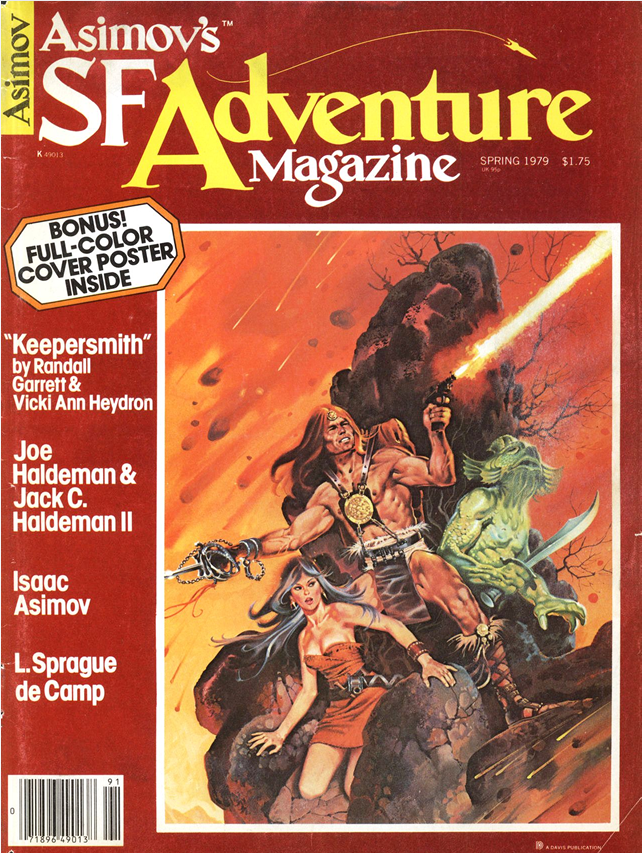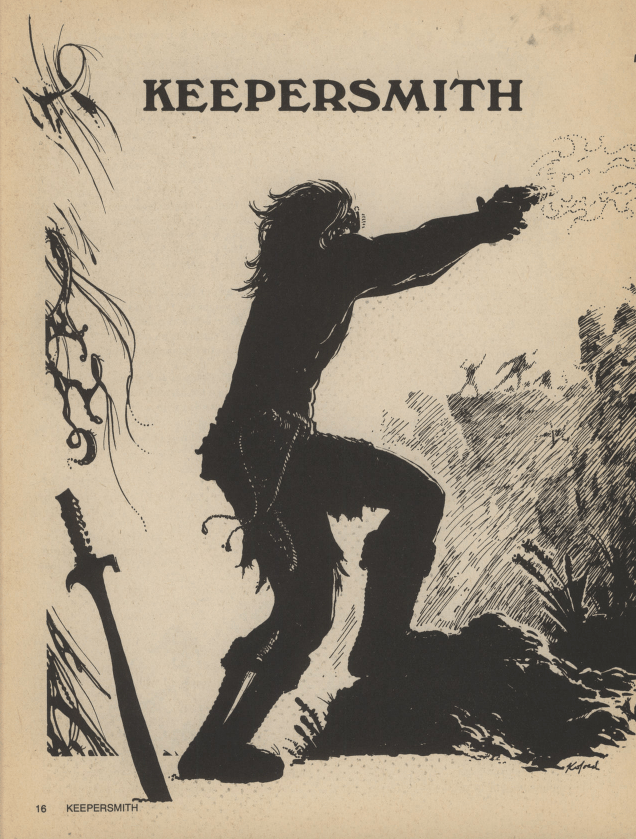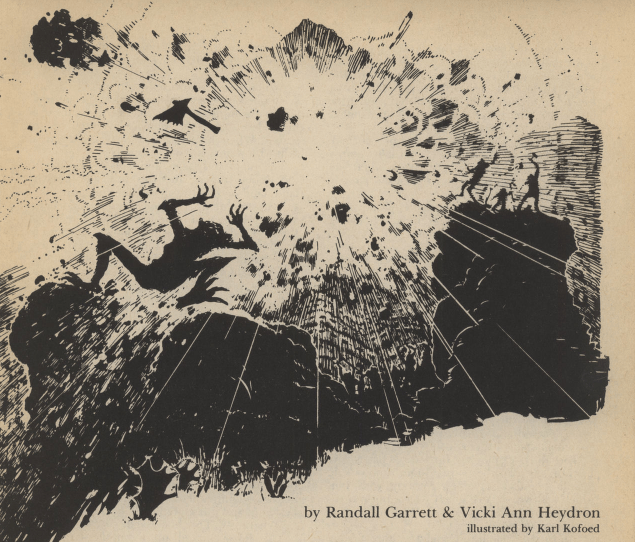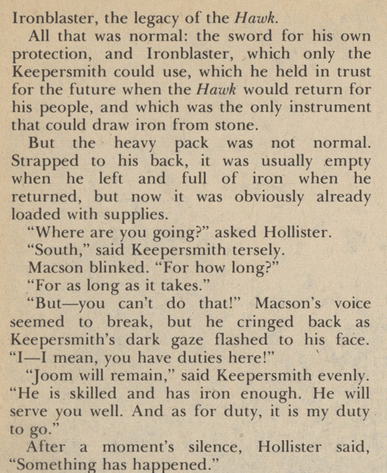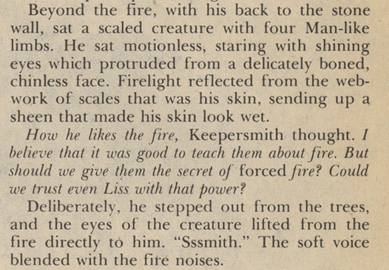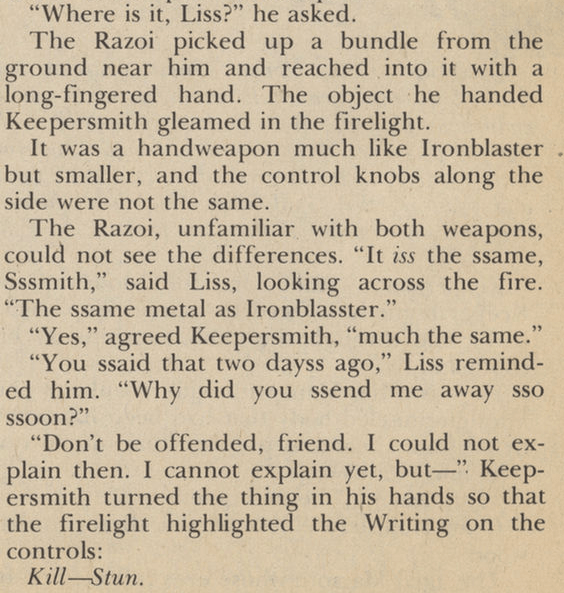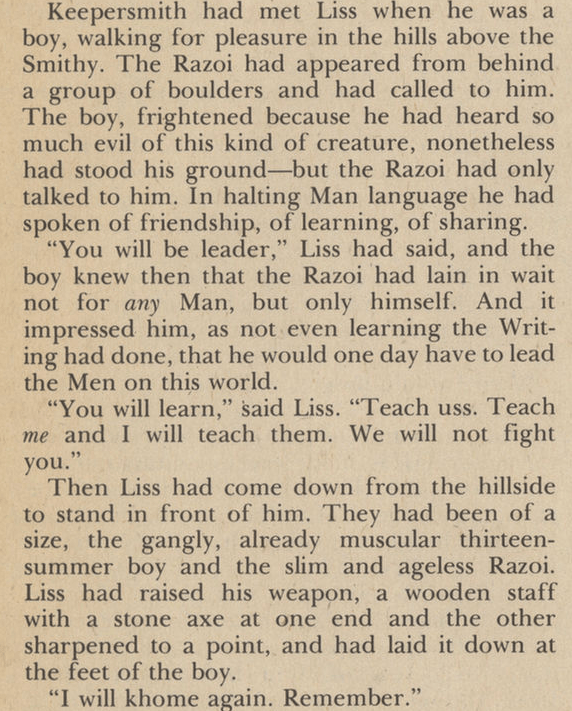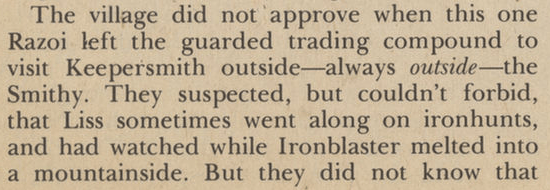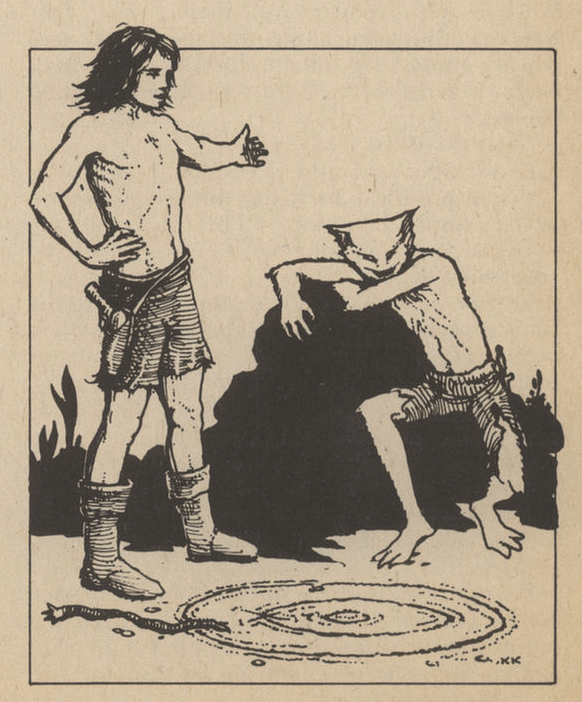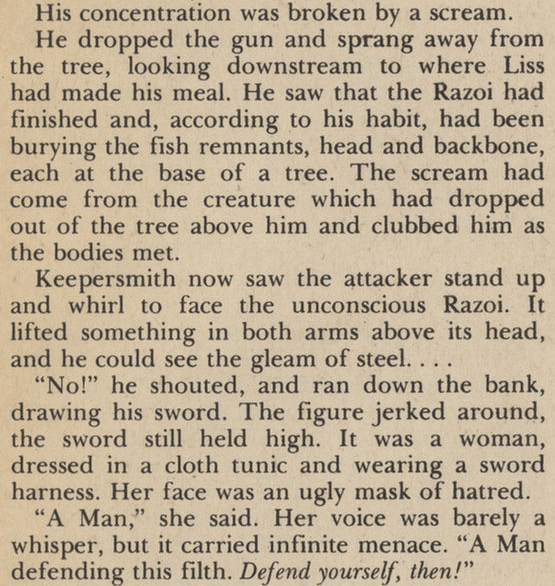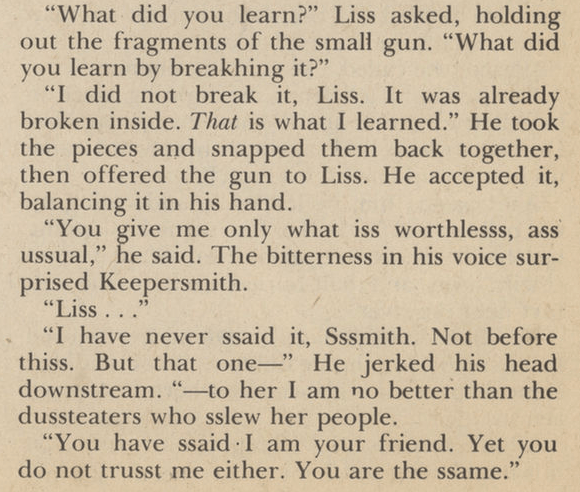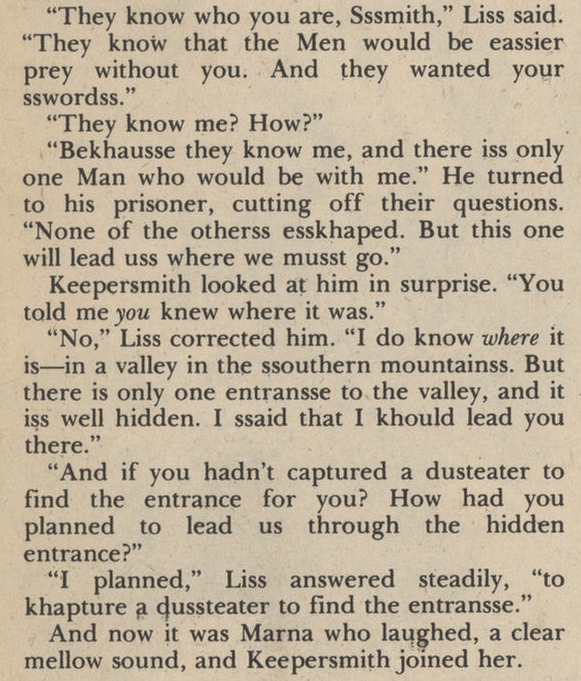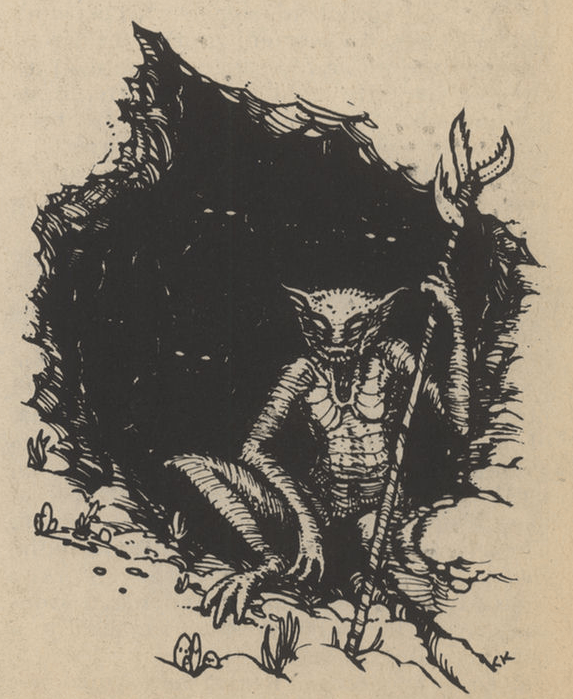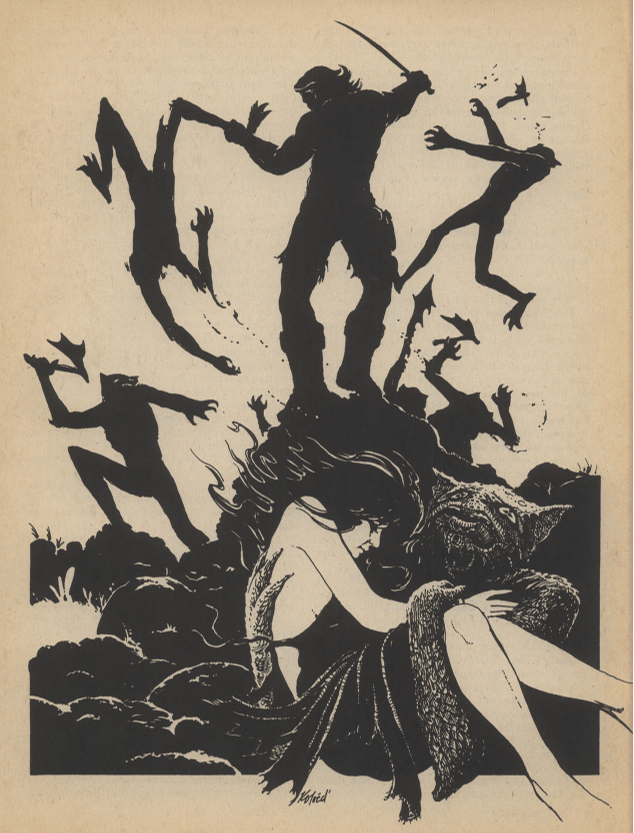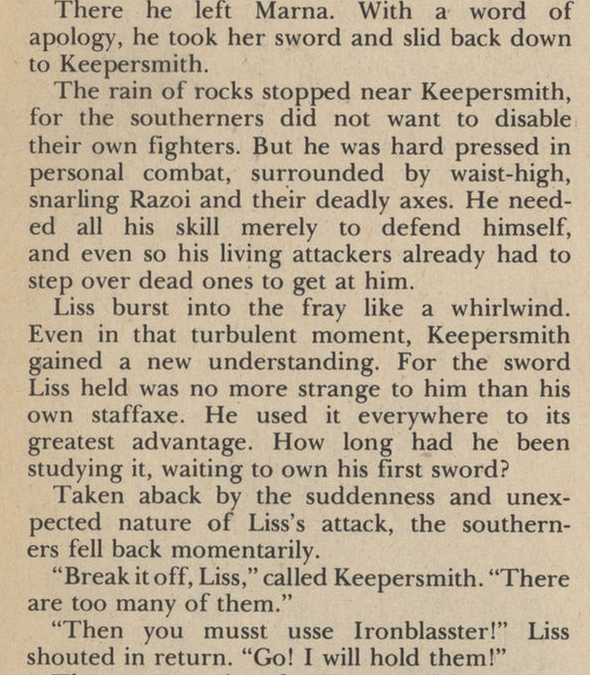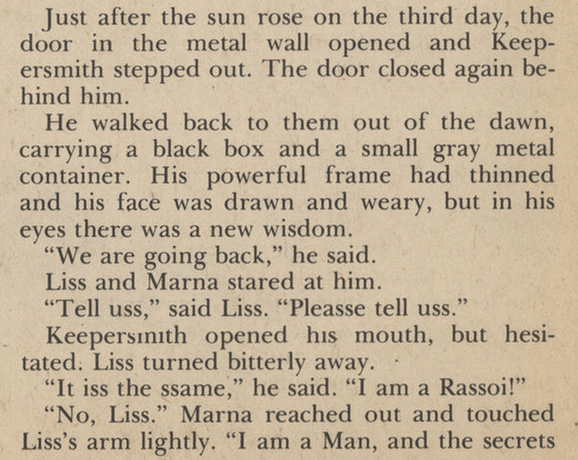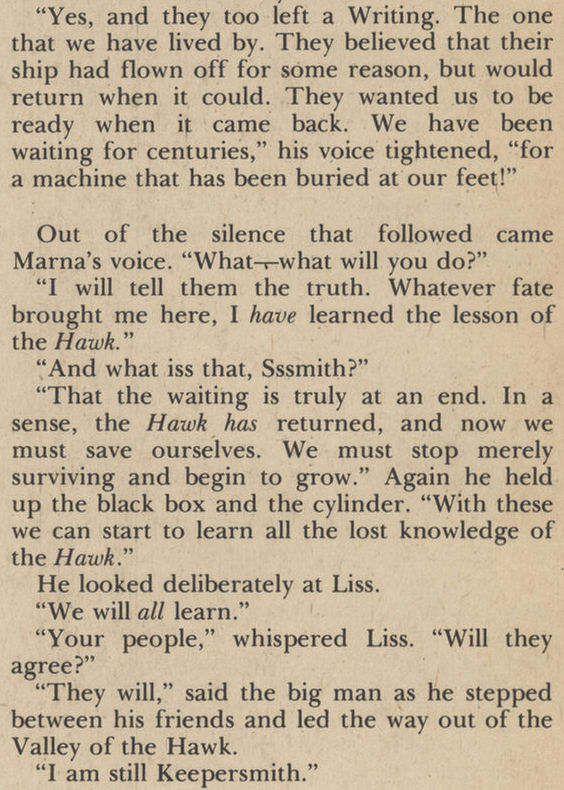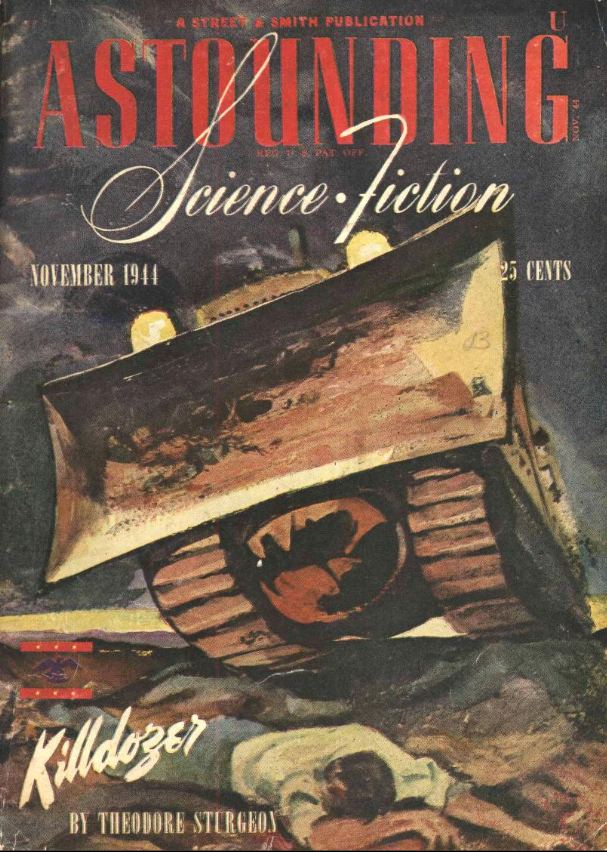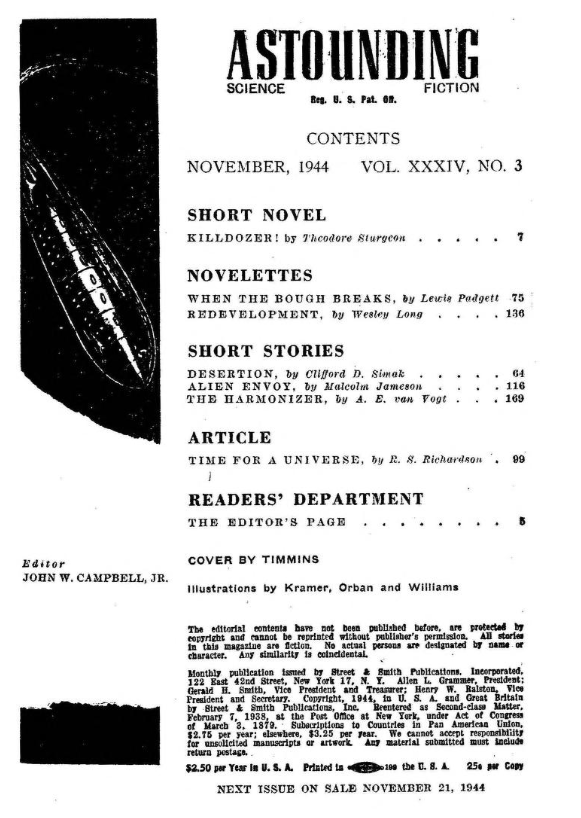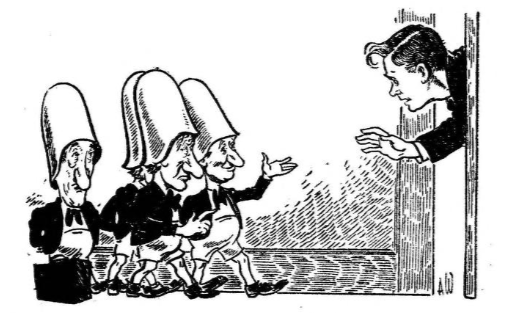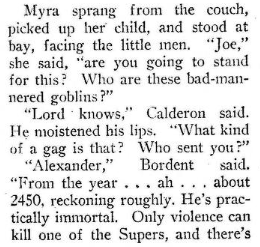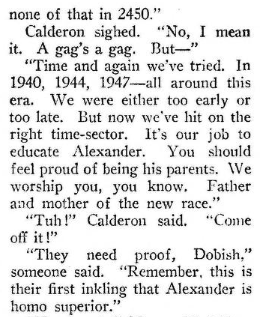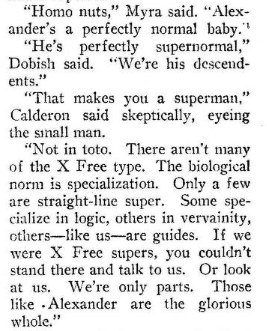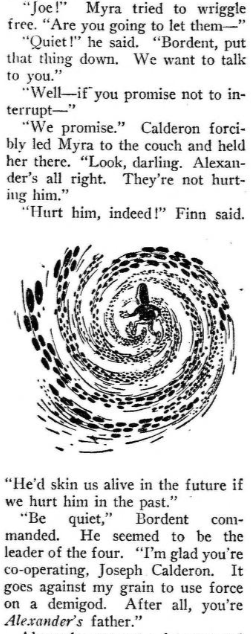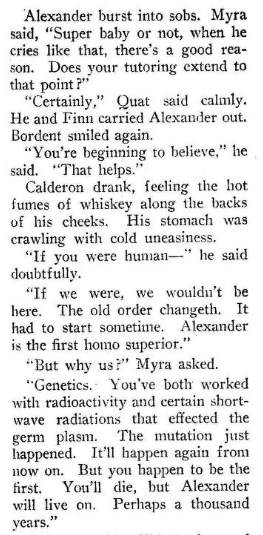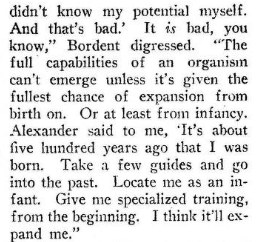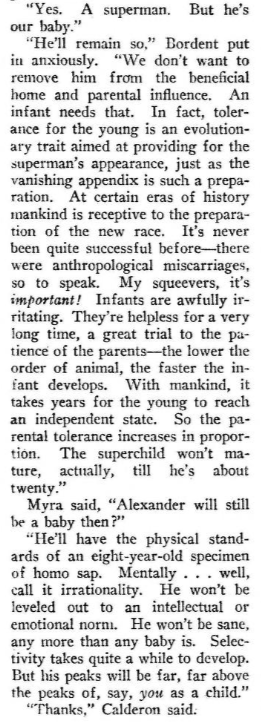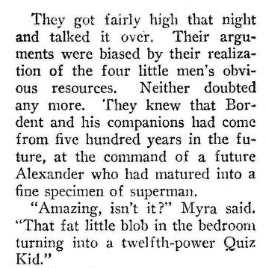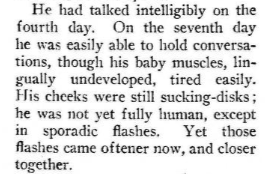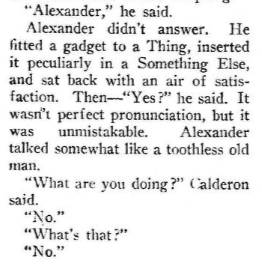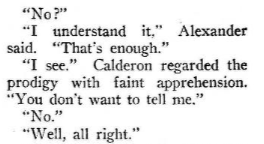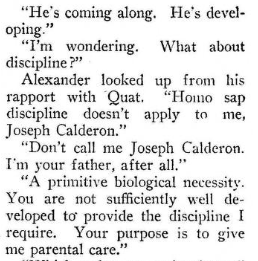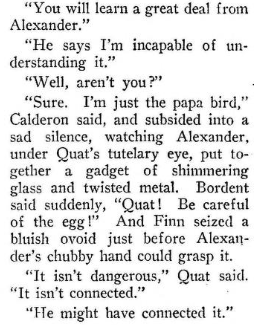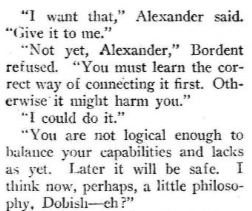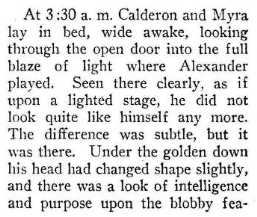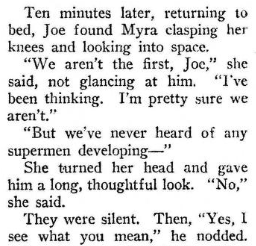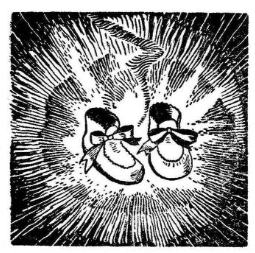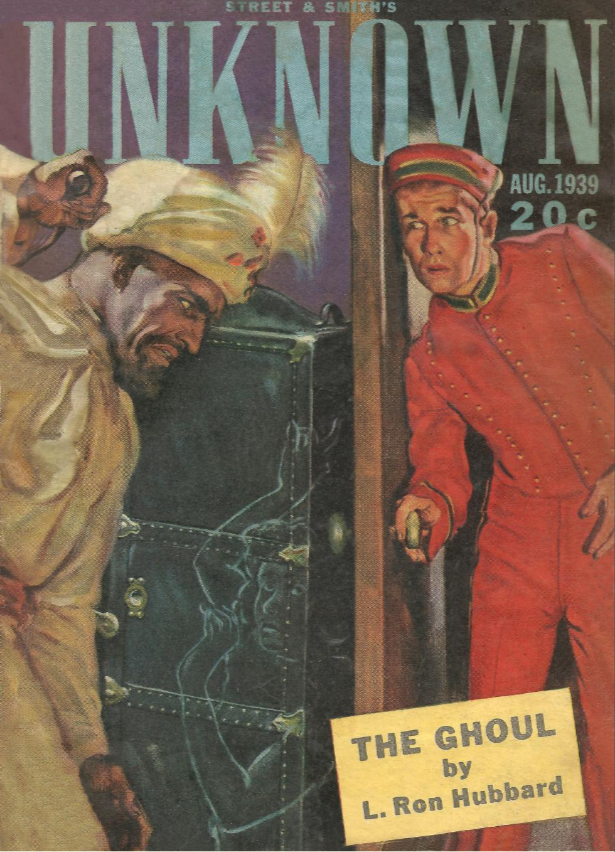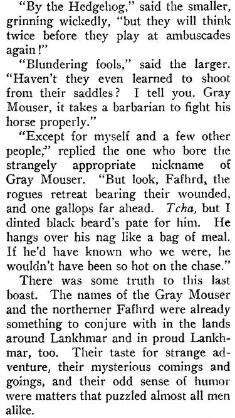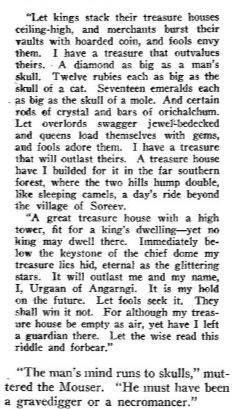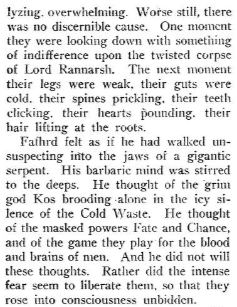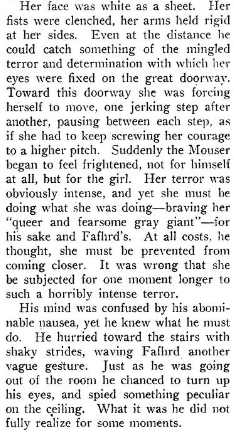We’re in the home stretch for Hallowe’en now, so lets try and get some good chilling pulp fiction discussions going on, shall we? It’s nice here in Austin now, too – we finally got some rain, our first in like forty days, and in addition to filling up the rain tanks (we’ve got about 950 gallons of water storage now, which we put in right as the drought started, so it’s nice to finally have it full!) it has also gotten almost seasonable – low 70s as I write this, with overnight temps promising to hit crisp 60s and 50s. Not really what most people think of when we start talkin’ October country and all, but by Satan, I’ll take it!
The sudden shift to Fall(ish) weather and thoughts of The Season inspired the choice of stories today: it’s from the Mayor of October Country himself, Ray Bradbury, and his fun, mythopoetical story “The Scythe” from the July 1943 issue of Weird Tales!
Bradbury, of course, needs no introduction – a truly major figure in sci-fi, and he’s one of the rare genre guys it’s ok for your Very Serious Literary Types to praise, fer chrissake, someone who gets a pass for writing imaginative fiction because it’s got such heart and verve and style. And it’s all very justified; Bradbury is one of the greats (though Fahrenheit 451 sucks), and he’d be rightly numbered among the Titans for The Martian Chronicles, easily one of the greatest short story collections in history, a true masterpiece. And, while he’s often remembered mostly as a sci-fi guy, he’s also got some serious Weird Fic chops too (I’d argue that’s why his sci-fi was so successful, actually; there’s a vital strain of weirdness, and all that implies, when he’s writing about Martians, for instance)!
In fact, Bradbury got his start in the pages of Weird Tales, writing something like 20 or 25 stories between 1942 and 1948, if I remember correctly. This is all post-Wright, of course, and I think Bradbury benefited from Dorothy McIllwraith’s tenure as Editor; his weird fic seems to fit nicely into her vision of the genre, I think, a slightly sentimental (though rarely sappy) atmosphere shot through with real glimmers of coal-black darkness. And, of course, Bradbury’s first collection, Dark Carnival, was published by August Derleth’s Arkham House in 1947. That’s what you call a serious Weird pedigree!
(As an aside, if you’re interested in a great and extremely granular biography of ol’ Ray, I’d highly recommend John Eller’s THREE VOLUME biography from University of Illinois Press, Becoming Ray Bradbury, Ray Bradbury Unbound, and Bradbury Beyond Apollo. They’re great, very interesting and with considerable attention to the details of his papers, correspondence, and archives, as well as putting his work and life in important historical contexts. I will say, though, that you should be prepared for Bradbury’s extremely bad politics, particularly later in life – he was a Reagan fan and was extremely anti-affirmative action, basically your bog standard boot-straps-and-elbow-grease small gov’t libertarian, not as ugly or as bad as, say Niven, but still dumb as hell! It’s shocking, until you start thinking about his deep nostalgia for midwestern childhood. Oh well!)
Anyway, let’s look at this issues cover and ToC:
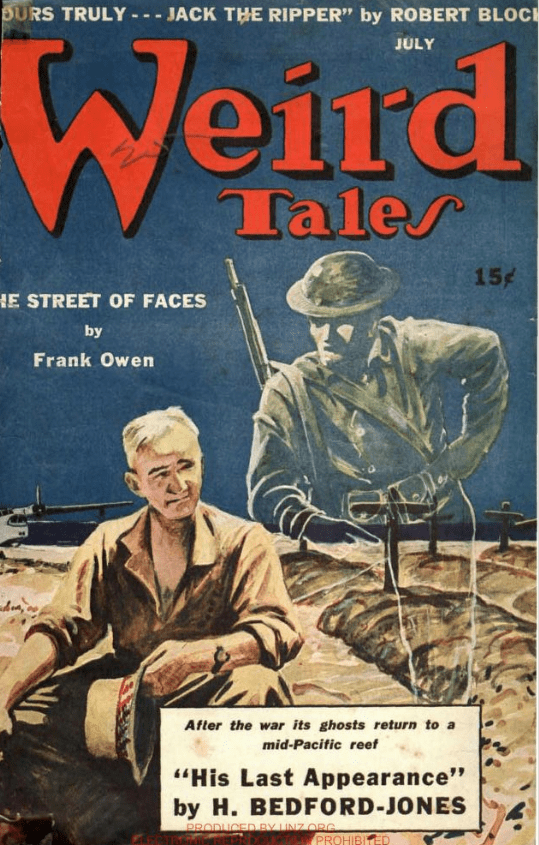
A quiet, contemplative cover for this July 1943 issue, particularly interesting given the date that this issue came out. The cover is for the Bedford-Jones story, “His Last Appearance,” and it posits an old soldier returning to the Pacific theater after the end of World War II. Of course, in 1943, WWII was still raging, with the siege of Stalingrad finally coming to an end, the beginning of the long brutal retreat of the Nazis westward, and the start of Allied plans for the invasion of Europe at the Casablanca conference. For Americans, WWII didn’t start until the Japanese bombing of Pearl Harbor in Dec 1941, and the war in the Pacific had been a long and brutal one in ’42, with the Fall of Manila and rapid Japanese advances in a number of places, including the Aleutians. But here we are, in 1943, with a story that is already imagining the war over!
It’s interesting to see the way the war was being interrogated in the public sphere and within the pages of the speculative fiction magazines at the time, imagining an end to the war and return to a more “normal” status quo in the near future. What’s missing from all these stories, of course, are the horrific specificities of future history, death camps and the Holocaust, V2 rockets and the Atomic Bomb, and the global detente of the Cold War. It makes for fascinating reading, glimpses into how people are grappling with such dramatic and profound events and changes. The Pulps give you a chance to really see the world and the people at very specific times, and they’re just fascinating!
As for the ToC:
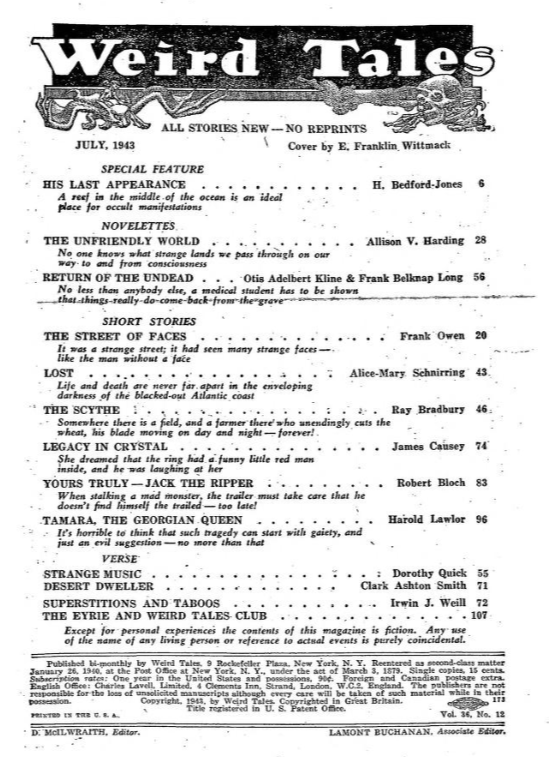
The big story here is Bloch’s “Yours Truly – Jack the Ripper,” probably one of his best and most famous stories. Bloch by this point in his career has basically exorcised Lovecraft from his work, having found his own style, tone, and topics of interest outside of the shadow of the Old Gent. Bloch’s “Ripperverse” work is an important part in his career, both because it laid the groundwork for his intensely psychological interest in murderers/serial killers, but also because it would lead his to write “A Toy for Juliette” in Harlan Ellison’s epochal anthology Dangerous Visions; so taken with the story was Ellison that he would write a sequel, “The Prowler in the City at the Edge of the World,” which he put in right after Bloch’s story in the collection. Anyway, it’s fun to see the beginnings of all that right here in Weird Tales!
Enough jibber-jabber, on to our story today, “The Scythe” by Ray Bradbury!
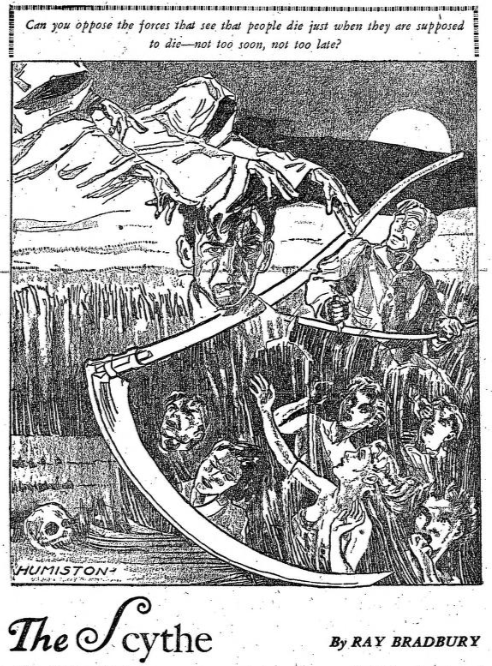
Look, the art in WT at this time…it ain’t what it used to be, okay? This is a perfectly evocative image, a little rough maybe, but it gets the job done I suppose. Still, makes you dream of the days of Finlay, don’t it? Also, I’ll just point out, that this is yet another example of the art giving too much away from the story; combined with the little blurb thing at the top of the pic, you definitely start this story with far too much information, in my opinion. Oh well! We’re used to it by now, but it’s still annoying as hell!


There’s no denying it – Bradbury knows what he’s doing. Great sudden in medias res opening here, and the short, percussive first sentence (“Quite suddenly there was no more road.”) is nigh on a perfect way to start the story, evocative and sharp and perfect, and a great lonely image. A road winding on through farmland, leading past trees and the stones and then a farmhouse and a wheatfield and then, as if it’s job were done, the road dies. Great, great stuff!
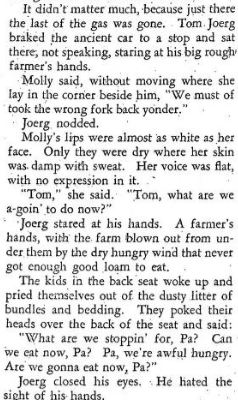
We’re introduced to some characters who might’ve escaped from the “Grapes of Wrath,” or maybe they’re just off-broad versions. “Tom Joerg” seems awfully close to “Tom Joad,” doesn’t it? And, like their Oakie comrades in Steinbeck’s book, they’re having a rough time of it, having followed this road that goes nowhere and running out of gas. A long-suffering wife and some hungry kids – that’s what you call prairie pathos, man.
What’s also interesting is that section there in the middle, where Tom starts looking at his hands. The writing is great of course (“farm blown out from under them” is a gem), but it also very specifically evokes the image of the dust bowl, doesn’t it? Now, while the droughts and soil loss and economic collapses continued into the 40s, it was even then very strongly associated with the 30s. Bradbury is priming us for the fact that, while this story was published in ’43, it probably took place earlier. The timeline is very important to this story, indeed is one of it’s major points, so we’re being prepped here. A neat bit of mechanical work, is my point, that Bradbury is doing here.
Starved, lost, and without anything else to do, Molly suggests to Tom that he head on up to the little farmhouse and see if they couldn’t spare a bite for the travelers. Tom swallows his pride and stumps on up to the house:
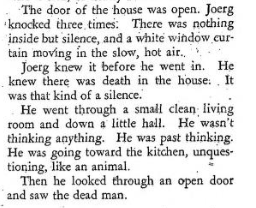
The knocking three times has some kind of mystical resonances, doesn’t it? There’s the trifold symmetry of time, Past-Present-Future, there, but there’s also a sense of “asking three times” being the amount that signifies contractual obligation in magical relationships. Anyway, Tom enters the house and his spidey-senses start tingling immediately. Sure enough, he finds a dead body, an old man clutching a single blade of ripe wheat and a scythe leaning against the wall. Weird as that is, Tom finds that the old man apparently anticipated his death, and left behind what amounts to a will:
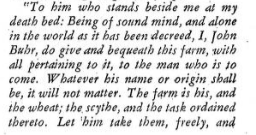

A lot here! First, and of most immediate importance, is the fact that the Joerg’s are now landowners – the old man has bequeathed the house and land to whoever has found him. What would give me pause, of course, is the next bit, which comes off as a little weird: take the farm AND THE TASK ORDAINED THERETO, and take ’em freely and unquestioningly. That’s a magical compact right there, a binding of Joerg to the land and some unspecified job that has to be done.
Also, we get a date here – April 1939. Note it!
Tom seems a bit spooked, but he and Molly quickly accept this lucky twist of fate. They take the farm as offered, and plan to start living the good life there in the middle of nowhere.


Not quite sure what the economic benefit of growing a fast-dying/fast-sprouting variety of wheat is! Also, it’s planted on a vast scale, and it seems to ripen in weird, localized clusters or zones. But he seems driven to cut it!
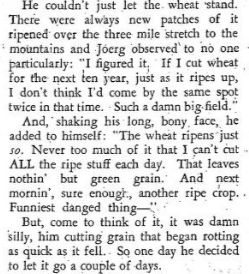
It’s strange, and it makes me wonder how exactly the farm is supporting this family, but after a while Tom decides that this preternatural wheat can go fuck itself, and he decides to stop cutting it. How’s that work out for him, you ask? Well:

He took the farm, and with it the APPOINTED TASK which, apparently, is to cut the weird wheat, day in and day out, unceasingly. Or else! The details of the task elude him, save for the necessity of it, the necessity of cutting the grain down when and where it is ripe in this strange stretch of field, not harvesting, not tilling, not planting, just cutting it down as it comes up, over and over again, letting it sprout and grow where and when it does. Extremely strange and mythic, isn’t it? And then, when he’s harvesting, he suddenly has a very strange, very mysterious reveleation:
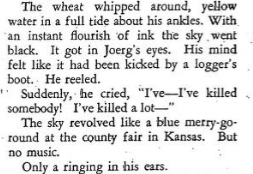
Great writing, the sudden vertiginous sense of disorder and confusion that Tom feels is very ably conveyed to the reader – what is going on? Why’s he freaking out now? Tom runs into the house, half-panicked, but eventually he can get the words out to Molly:
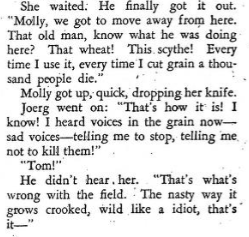
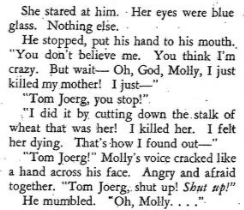
Pretty spectacularly weird isn’t it – he’s literally a grim reaper, ending a thousand lives every time he cuts a single stalk of wheat in that uncanny field. It seems like maybe his exposure to the work has, slowly, given him insight into its nature, or maybe the fact that he had some relationship to one of the lives he just cut down has triggered his illumination, but it doesn’t matter – Molly thinks he’s nuts, and Tom knows he’s not. Molly tells him to shut up, that they’ve got a good thing going with this farm (I guess there must be other food crops, and a cow or two, so that’s how they’re eating?). And she reads the Bible at him all week, I guess trying to get him to settling down, until of course a telegram arrives letting Tom know his Mom DID die, on the very day that he had his wheat-based freak out.
Tom wants to leave, but Molly is made of sterner stuff. She shoots his California plan down and tells him that by God they’re staying right there, where they’ve got a home and food and future! And, realistically, what can Tom do – we (and he) must know that he’s made the deal, he’s accepted the job, and the job HAS to be done.
With a certain mid-western pragmatism, Tom begins to accept the inevitability of his task. He communes with the grave of his predecessor and contemplates the long-line of harvesters that must’ve come before him, down to prehistory. (As and aside, the idea of the Cro-Magnon harvester is funny and strange – so like, before agriculture there were cavemen forced to chop down the Magic Sheaves of Life and Death? It’s an odd, incongruous image, but one we’ll just have to forgive Bradbury for).
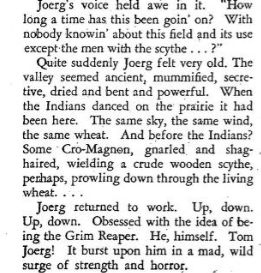
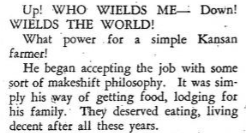
Now we’re getting into the real interesting part of the story – there’s a little musing here about what Tom’s relation to the Work is. He’s not KILLING the people, not maliciously – he’s just doing a job, taking care of his family. An interesting bit of ethics to consider, maybe, though Tom abandons it when he has the brain flash that, if he could find his and his family’s wheat stalks, why, could they live forever? I’m sure this magical wheat never considered that loophole before!
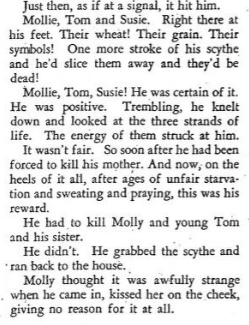
No sooner thought than answered – Molly and his kids’ time HAS come, he HAS to cut them down…and he can’t! He decides to fight fate!
Over supper Molly asks some questions about the wheat, even suggesting that Tom oughta call in the Extension boys from the local Ag Dept to have a look – what the hell good is this weird wheat that rots immediately, anyway? Tom is horrified – what might the GOV’T do with the Grain of Life and Death, after all? It’s a neat little part of the story, another of those little asides that Bradbury raises and which run a chill up and down the ol’ spine as you regard them in the story. It’s fun! Of course Tom is having no part of it. Molly doesn’t think the Wheat of Fate is real, but Tom KNOWS it is.
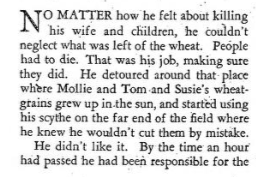

Grim stuff, and Tom again tries to abandon the work, locking up the Scythe and choosing to ignore the wheat…but then Molly begins to suffer from a strange kind of lassitude, and his kids seem to whither and fade a bit too, afflicted with a kind of odd malaise. He doesn’t know what will happen to them, or to the countless thousands he has refused to reap, but he’s going to wait and see…
…and of course he wakes in the middle of the night out in the field, with the scythe in his hand, being driven by a mad compulsion to DO THE JOB. He fights it, struggles mightily…
…and then the house fuckin’ blows up!
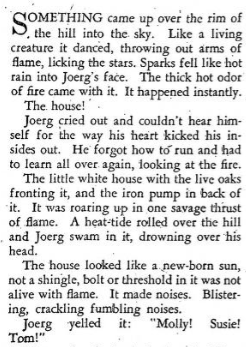
Horribly, Molly and Susie and Tom Junior AREN’T dead…they’re trapped behind horrible walls of flame a smoke between life and death, unresponsive, unaware, undying. It’s a horrible scene, and there’s some very fine writing here as Tom is forced to confront the implacable nature of Life and Death. He brings his family out onto the lawn, cold and sleeping beyond death, and realizes that he cannot abandon the task, that he cannot have a life anymore – he is the grim reaper.
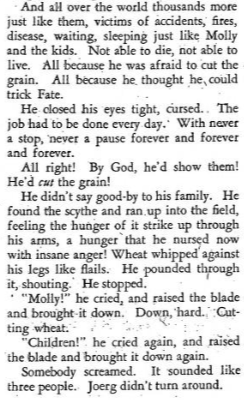
Pretty horrible scene, isn’t it, the image of his family just out of sight screaming and dying as Tom, chained to the merciless scythe, cuts through the wheat in the night. Grim as hell!



There’s the significance of the date of the story coming around: 1939, and the beginning of the Second World War.
Is Tom *causing* it, do you think? Is he heedlessly cutting, maybe cutting more than he should, causing a horrible war and its aftermath out of his grief? Or is he simply, heedlessly, heeding the wheat, cutting madly because that is what has been Fated? It’s not clear, and that ambiguity is troubling and, of course, probably the point.
And as for Tom?
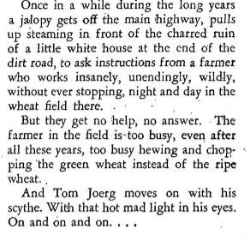
And that’s the end of “The Scythe” by Ray Bradbury!
Tom keeps on cutting – again, is he causing the accelerating deaths, the horror of modern warfare and conflict and imperialism and transnational capitalism, or is he merely the instrument of it, his feverish monomania and ceaseless toil a product of OUR horrible times?
It’s a nice little story, I think, and it really captures a very pure strain of myth that Bradbury often mined in his work. It’s also an interesting time capsule, a writer watching the world around him ending and reflecting on it, what it meant to him and society. A good reminder of the power and possibility of pulp literature!


